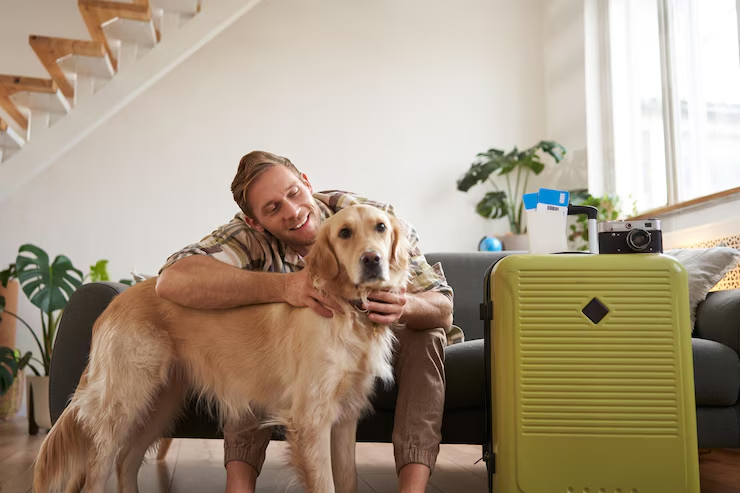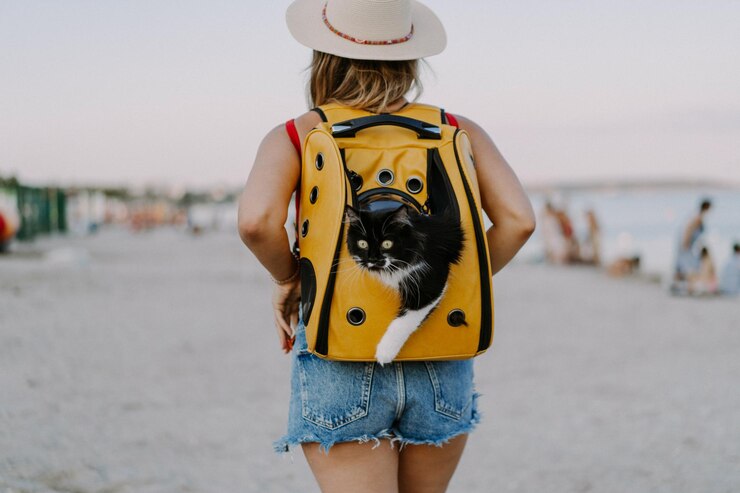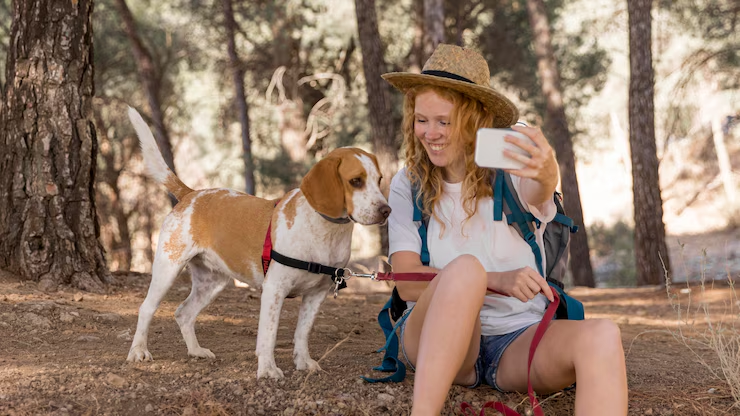Bringing your furry friend along on a trip can be an incredibly rewarding experience. Pets are more than just animals. They are members of the family. So, it’s only natural to want to include them in your travel adventures. Whether you’re planning a weekend getaway to the countryside or embarking on a cross-country road trip, traveling with pets requires a bit more thought and preparation than traveling solo. From ensuring their safety and comfort during the journey to finding suitable accommodations and activities, every step matters.
In recent years, pet travel has become more popular, with more hotels, airlines, and public spaces adapting to accommodate four-legged companions. However, this increased accessibility doesn’t mean that pet travel is without its challenges.
This guide is designed to walk you through every essential step of the process. If you’re traveling by car or plane, exploring pet-friendly destinations, or preparing for long-term relocation with your pet, we’ve got you covered. We’ll also touch on seasonal considerations, international travel, and how to handle emergencies when you’re on the go. With a little planning and the right mindset, traveling with your pet can be an enjoyable and unforgettable adventure.

Preparing for a Road Trip with Your Pet
Road trips offer a flexible and often less stressful way to travel with pets, especially dogs. The first step is getting your pet accustomed to the car. If your pet isn’t used to riding in a vehicle, begin with short drives to fun destinations like a park. Gradually increase the length of these trips to help your pet build a positive association with car travel.
Before setting off on a long journey, make sure that your pet is healthy and up to date on vaccinations. Schedule a vet appointment to address any concerns and get a copy of your pet’s medical records in case of emergencies. Ask your vet about motion sickness remedies or calming aids if your pet shows signs of stress during car rides.
Pack a travel kit with essentials such as food, water, collapsible bowls, a leash, waste bags, grooming supplies, and your pet’s favorite toys or bedding. Make sure your pet’s ID tags are current and securely attached to their collar. Microchipping your pet is also a wise decision for added security.
When on the road, plan for regular breaks every two to three hours so your pet can stretch, relieve themselves, and have a drink. Never leave your pet alone in a parked car, even for a short time. Temperatures can get high quickly, creating a dangerous situation.
Use a pet restraint system like a harness seatbelt or travel crate to keep your pet secure. This not only protects your pet but also prevents driver distractions. Safety and comfort should be your top priorities during any road trip.
Flying with Pets: What You Need to Know
Air travel with pets is more complex than driving, but it can be managed with proper planning. The first thing to consider is whether your pet is suited for flying. Some animals, especially short-nosed breeds like pugs or Persian cats, might experience respiratory issues on planes and should only fly if it’s absolutely necessary.
Research the airline’s pet policy before booking. Each airline has different rules regarding pet travel, including carrier requirements, breed restrictions, and health documentation. Decide whether your pet will travel in the cabin or the cargo hold. Small pets that fit in an airline-approved carrier can usually stay with you under the seat, while larger pets may need to be checked as cargo.
Visit the vet to make sure that your pet is fit to fly. You’ll likely need a health certificate issued within ten days of departure. Some airlines also require proof of rabies vaccination. If you’re flying internationally, check the import requirements of your destination country, which may include quarantine or additional paperwork.
Choose a comfortable, well-ventilated carrier that meets airline guidelines. Place a familiar blanket or toy inside to soothe your pet. Avoid feeding your pet a large meal before the flight to reduce the risk of nausea.
Arrive at the airport early to allow ample time for check-in and security procedures. If your pet is traveling in the cargo hold, confirm that the hold is climate-controlled and that your pet will be handled safely. Once on board, try to stay calm because your pet can sense your emotions, and your relaxed demeanor will help ease their anxiety
Taking the Train with Your Pet
Traveling by train can be a comfortable and scenic option for both you and your pet. Many railway companies now allow pets on board, though the rules and restrictions vary widely depending on the country and provider. Before booking, research the pet policies of the train service you plan to use. These often include size and weight limits, carrier requirements, and sometimes additional fees.
Most trains require pets to be kept in a secure carrier that fits under your seat. Make sure your pet is accustomed to the carrier and feels safe inside. Soft-sided carriers with proper ventilation are usually the best choice for train travel. For larger pets, some services allow animals to travel in designated areas or cars, though reservations may be necessary.
Be prepared to handle bathroom breaks at station stops, especially on long journeys. Trains can be noisy and crowded, so monitor your pet’s behavior and comfort them when they need it. Choose travel times when trains are less busy, and opt for seats in quieter areas if possible. Train travel is often less stressful than flying and more spacious than car travel, making it a great middle ground for many pets.
Keep your pet’s documentation on hand, especially if traveling internationally or across state lines, as some train companies require health certificates and proof of vaccination.

Choosing the Right Travel Bags and Carriers
The right travel bag or carrier can make a world of a difference when traveling with pets. For small dogs and cats, soft-sided carriers are often preferred due to their flexibility and comfort. These are especially useful for air travel, as they can be placed under the seat. Look for carriers with good ventilation, sturdy zippers, and padded interiors.
Hard-sided carriers offer more protection and are ideal for car travel or for pets that tend to chew. They provide a solid structure that keeps your pet secure. Make sure the carrier is large enough for your pet to stand, turn around, and lie down comfortably.
Backpack carriers are a great hands-free option for smaller pets, especially if you plan on hiking or walking a lot. There are even wheeled carriers for those who prefer to roll rather than carry their pet. The key is to choose a bag that suits your travel style and your pet’s needs.
Travel crates for larger dogs should be International Air Transport Association approved if you’re flying. These crates are designed to meet specific safety standards and often include features like secure locking doors and ventilation on all sides.
Always introduce your pet to the carrier well before your trip. Let them explore it at their own pace and offer treats to create a positive association. This step is crucial to making sure they feel safe and relaxed while inside.
Finding Pet-Friendly Accommodations
Not all accommodations welcome pets, so it’s essential to do your research in advance. Many hotel chains now offer pet-friendly options , but policies can vary widely in terms of fees, weight limits, and number of pets allowed.
Use dedicated websites or apps that specialize in pet-friendly lodging to streamline your search. Look for places that not only allow pets but also provide amenities like pet beds, bowls, and even pet-sitting services. Reading reviews from other pet owners can offer valuable insights into how truly welcoming a place is.
When booking, always confirm the pet policy directly with the property. Ask about any restrictions, deposits, or additional cleaning fees. Some accommodations might require proof of vaccinations or a signed waiver.
Once you arrive, make your pet feel at home by setting up a comfortable space with their familiar items. Keep your pet leashed or in a carrier when in public areas of the hotel , and be mindful of noise to avoid disturbing other guests.
If you’re staying in a rental or vacation home, inspect the area for potential hazards like open windows or toxic plants. Always clean up after your pet and respect the property to ensure a positive experience for both you and the host.
Planning Activities Around Your Pet
Traveling with a pet means adjusting your itinerary to include pet-friendly activities. Whether it’s a beach day, a nature hike, or an outdoor cafe, your pet will appreciate being part of the adventure.
Research pet-friendly attractions and parks in advance. Many cities now have off-leash dog parks and trails where pets can run freely. If you plan to dine out, look for restaurants with pet-friendly patios. Some establishments even offer special menus for dogs.
Remember that not all activities are suitable for pets. Avoid exposing them to extreme temperatures, crowded events, or unfamiliar environments that could cause stress. Always prioritize their comfort and safety.
If you plan to visit a place where pets aren’t allowed , arrange for pet care in advance. Many destinations offer local pet-sitting or daycare services. Leaving your pet in a safe, supervised environment is better than risking their well-being in unsuitable conditions.
Handling Emergencies on the Go
No one wants to think about emergencies while traveling, but being prepared can make all the difference. Start by identifying nearby veterinary clinics at your destination. Keep a list of emergency contacts, including your vet’s number and a local animal hospital.
Bring a basic pet first aid kit that includes items like bandages, antiseptic wipes, tweezers, and any necessary medications. Knowing how to perform basic first aid can be lifesaving in urgent situations.
If your pet gets lost, having updated ID tags and a microchip significantly increases the chances of being reunited. Keep a recent photo of your pet on hand to share in case you need to post lost pet alerts.
Stay calm and act quickly in emergencies. Whether it’s a medical issue , an escape, or an accident, your composed response will help guide your pet through the situation.
Pet Travel Etiquette and Social Responsibility
When traveling with a pet, courteous behavior goes a long way. Always keep your pet under control and supervise interactions with strangers or other animals. Be respectful of others by cleaning up after your pet and following all leash laws and property rules.
If your pet tends to bark or meow excessively, consider accommodations and settings where this won’t disturb others. In public spaces like restaurants or parks, only bring pets that are well-behaved and sociable. Not everyone is comfortable around animals, and it’s important to be considerate.
Traveling with Exotic or Non-Traditional Pets
While dogs and cats are the most common travel companions, some people travel with birds, rabbits, reptiles, or even ferrets. Each of these animals has unique needs. For example, reptiles require a stable temperature range, which can be difficult to maintain while on the move.
Birds can be startled by unfamiliar environments and noise. A sturdy cage with secure doors and a familiar perch or toy can help calm them. Check legal restrictions, especially when crossing borders, as exotic animals are subject to more stringent regulations.
Always bring a specific travel plan tailored to your pet’s species, including dietary needs, enclosure security, and emergency contacts with experience in treating that type of animal.
Seasonal Considerations for Pet Travel
Weather plays a significant role in pet travel planning. Summer heat can be dangerous for pets left in cars or on hot pavement, while winter cold can pose hypothermia risks. Adjust your travel plans to minimize exposure to extreme temperatures.
If you are traveling during the holiday season, remember that crowded airports, fireworks, and festive gatherings can be overwhelming for pets. Calming aids or noise-dampening wraps might help, and keeping your pet in a quiet space is often the best strategy.
Spring and fall generally offer the most pet-friendly weather for outdoor activities and sightseeing.
Tips for International Pet Travel
International travel with pets involves additional documentation, vaccinations, and sometimes quarantine. Start the planning process months in advance. Research your destination’s import requirements through official government websites.
Most countries require a pet passport or an International Health Certificate, often endorsed by a government authority. Microchipping and rabies vaccinations are almost required, and some countries require treatment for tapeworm or other parasites.
Certain islands and regions may impose quarantine periods, so take this into consideration when planning. Use a professional pet relocation service if you are unsure about meeting all the regulations.

Handling Long-Term Travel or Relocation with a Pet
If you’re moving abroad or embarking on extended travel, helping your pet adjust is crucial. Start with routine and familiarity: bring their bed, toys, and regular food brand if available. Keep a consistent feeding and exercise schedule.
Locate a local veterinarian soon after arrival and register your pet. Update your pet’s ID tags and microchip registration with your new address and contact number. Find nearby parks or walking routes to help your pet settle into their new environment.
Final Thoughts
Traveling with a pet is more than just a logistical exercise. It’s an opportunity to build stronger memories and deepen the bond between you and your companion. While each journey comes with its unique set of circumstances and potential obstacles, approaching the experience with patience, adaptability, and empathy will make a big difference. A successful trip isn’t just about reaching your destination but about the shared experience along the way.
Each pet is different, and what works for one might not suit another. Learn your pet’s travel style and comfort level, and be willing to adjust your plans accordingly. There might be times when detours or compromises are necessary to prioritize your pet’s well-being, but these choices often lead to meaningful moments.
Beyond the practicalities of travel, this kind of experience can strengthen your connection in profound ways. The moments you spend together navigating new places, overcoming challenges, and enjoying unfamiliar sights will become cherished memories. Whether it’s a spontaneous trip to a nearby town or a well-planned overseas vacation, the presence of your pet adds a layer of warmth and joy that few other companions can provide.
So, take the time to prepare, do your research, and trust the journey. Your pet might not thank you in words, but their wagging tail, purring, or eager enthusiasm will speak volumes.
If you are looking for a new pet travel bag, we have the perfect solution for you. Here is the Modoker Travel Bag. It has many compartiments for food and water and is also really sturdy. Check it out!
If you liked this article, here’s what to read next: Is Your Dog Getting Enough Exercise?












